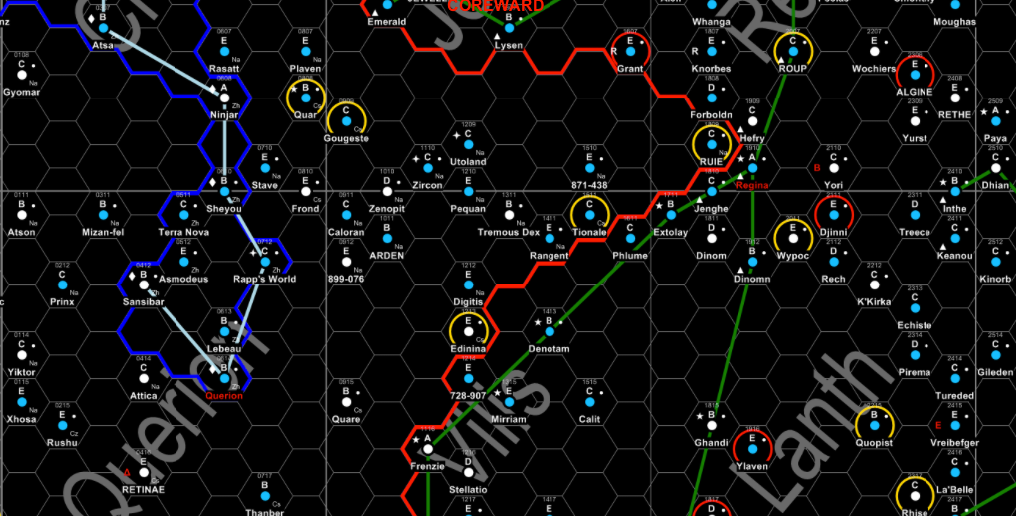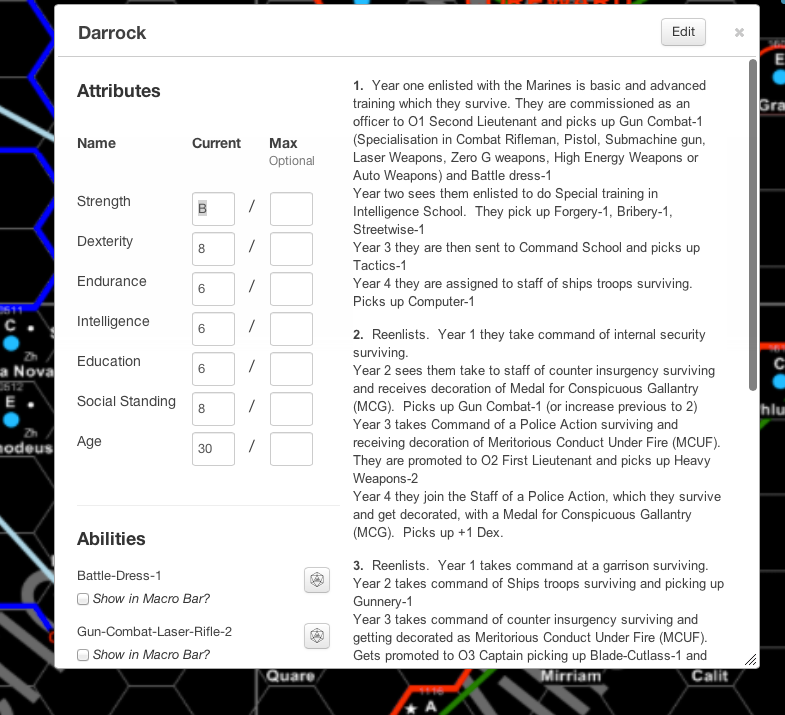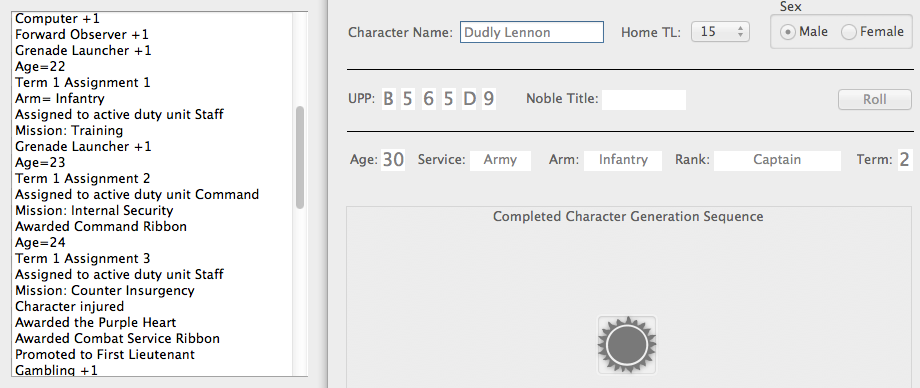Why Classic Traveller?
This was originally posted to the author’s blog at thepathfinderchronicles.com in July 2013 and reprinted with permission in the July/August 2016 issue.
This review is not of a single product within the line, as has heretofore been the norm, but rather a look at the entire line as an entity. We will happily print such articles in Critics’ Corner if submitted.
I have been asked a few times in comments and through posts why I chose classic Traveller (CT) over all the varieties of Traveller there are to play. CT is the first ever version of Traveller, hence the ‘classic’ title, but still seems to have quite a few followers out there on the internet which is a great thing to see. Why I played it initially is an amusing anecdote, and perhaps a little disappointing to many but I will elaborate on it in this post. I will discuss why I continue to play CT in the face of other more modern systems in due course after it, highlighting some of the strengths of CT that keep me playing it.

A portion of the Spinward Marches
that my players began in
OK, let us get the completely honest answer why I use CT for my sci-fi game. In essence, the game system was chosen before I decided to take the project on. My CT game came about as a request on the Google+ Asia-Pacific Tabletop Roleplaying game for a GM by Duncan McPhedran. The request simply asked if there was anyone willing to GM a game of CT via online hangouts. I had been thinking of running a sci-fi game at that stage, but I was going to run d20 Star Wars but I wanted to make it more of a sandbox style game that Traveller does so much better. I answered the post with a definite maybe. Then, without the coercion of anyone else in four comments and the purchase of the Deluxe Traveller box virtually (books zero to three and the map of the Spinward Marches), I had convinced myself this was the system to run. So, that is, in essence, the answer to why I play CT in my online game.
But the real question I think people want to know is why I stick with CT as my core rules. This is not as easy a question to answer and I have wavered on this topic over time. I can see as a GM it would be much easier for me to make a hack of Fate Core and run the game with that system. I have thought long and hard about putting this to the players but I have now put that aside for the time being. Using the CT rules is a harder way to run the game but I believe the benefits you get out of it using the system outweigh this amount of effort.
Before I go into too much detail about why I think my above statement is the truth I will qualify my own experience with Traveller. I have played a lot of Traveller in the past, but CT was busy being replaced by MegaTraveller at the time I started playing, so I never saw the ‘little black books’ version. I played in a game with a good GM, Kel Dennis, who basically house ruled a lot of stuff and ran a very story-based space opera-esque game for me. It was, and still is, one of the most memorable games I have been a player in. Hours and hours were sunk into the game. I later made a large purchase of MegaTraveller books but never ran a game in the system before on-selling them again.
My vision for the game that I am running was to use the existing Traveller universe in a sandbox manner. This allowed me to not have to delve too much into making star systems (though I still needed to populate the existing ones) and also gave those players that came to the game after having played it themselves previously a sense of nostalgia. I had not even finished reading the third book when we launched into our first game. I sat with an open notebook as well as a name generator web page and started throwing hooks at the players to see what interested them and the game developed from there.

This image is from the X3 computer game.
Closest thing to Traveller since Elite in the ’80s!
Of course, prior to the game I had informed the players that I intended to run a “merchant” style campaign. This allowed the players to take charge of themselves as they took to the “Big Black” in search of the best deals. Buying in one place, selling in another. It encouraged them to go forth and explored the regions of space that they wanted to and I would simply enable this to happen. I had only three long-term goals with this game, story-wise, and I would insert them into the game as I felt the players were ready for them. The first of these goals has been realised with the wreck of the Pandora and space station the most recent adventures we have tackled. I have two others that need to be matured before dropping them in play.
So, now we know more about my actual game I will tell you what I like about CT. The first and foremost thing that attracted me to the game is the trade system that is contained in Book 7: Merchant Prince. This system is a beautiful balance of algorithm that calls on the players to be pro-active in their trading. Running a Traveller starship is a costly enterprise that is two parts accounting, one part trading, one part negotiation, one part positioning and three parts luck. Honestly, merchant traders need to be on their game to ply the trade routes of the system. The resulting system is like a mini game where you can spend a good deal of time perfecting the right deals for the right price. Not to mention managing passengers and other opportunistic scenarios that may arise. This is the flavour of game I want to run. A party tied to a space ship for employment plying their trade skills to meet monthly payments to do it all over again a month after that.
Another part of CT that attracts me is the idea of basic generation as presented in Book 1: Characters and Combat as well as the more detailed character generations presented in Books 4 - 7 and also a couple of the supplement books. The idea that you can have a nicely balanced character in either format is really good. The basic version requires less attention to detail but it is up to you to fill in the blanks of what happened whilst the advanced version gives you a much clearer understanding of what your character had been up to in their career. The other thing I like about character generation is its random nature. You can start with a character concept but that may be altered via the twists of fate! You may even have to roll up several characters before you even get one that survives generation. Having a character generation system that is this risky is like a game in itself!
The maths of the system is also something that is impressive. The skill system is based on a 2d6 roll with a target number of 8 for a success. Modifiers apply to these rolls so if you have an applicable skill you add the level to the roll and other modifiers may apply from the referee determination. Statistics are the opposite where to make a statistics roll you roll the 2d6 and try to get under the valid statistic for a success. CT does not shy away from mathematical equations either. A lot of the system is actually wrapped up in scientific truth of the time of the game and is simulationist. In games where space travel is involved even at a light setting this can mean you are in for some pretty intimidating equations. I love this, and I also love the hexadecimal format of the statistics for a character.

There are few sandboxes bigger
than the Traveller universe!
I think that CT was set up with simplicity of characters at a premium. In other games I run (Earthdawn, Pathfinder) it can take me up to four or five hours to build a decent NPC. In CT, a decent NPC can be made in under 10 minutes including writing up all the statistics. There are six statistics for a character in CT: Strength, Dexterity, Endurance, Intelligence, Education and Social Standing. No matter the character they are recorded in a UPP (Universal Personality Profile) as six hexadecimal digits (giving a range of 0 - 15 in this format 0, 1, 2, 3, 4, 5, 6, 7, 8, 9, A, B, C, D, E, F) guaranteeing that the UPP only ever contains 6 entries. In reality these numbers are run together so generally appear like 4A3797 to define the statistics in the order as described above. All that needs to be added is skills and equipment and you are away. The range of skills does depend on which books you are using to play the game. The thing I really like is to have familiarity in a weapon you need a skill specific to that type of weapon. If you are using a laser rifle you can not use your Assault Rifle skill as a substitute as the two are about as similar as a Hiver to a K’kree.
There is also a mass of material out there in the CT universe! Websites full of fans love for the game has translated into a wealth of material. The little black books have been reprinted recently so you could get them in physical format or if you want practically everything that was ever printed for CT in a PDF format there is a cheap way. The Far Futures Enterprise company sell everything that was printed for CT in PDF on a CD for $35 USD plus P&P. To me that is awesome value! Every module, every book, every supplement, every board game and even the Lost Rules PDF all on one disc. It did take them a while to get it to me but it has been worth the wait! I am reading full time just trying to soak up the information and working out what I am going to include in a program that can automate some of the rules when we need them.

A Traveller character in Roll20
CT can be a daunting system when you actually look at all the books that were included in the system. The good thing to know is that it was designed to be run with just the first three books in the series so there is no need to be overwhelmed by it all. I have not as yet finished reading all the little black books so at times I am referring to the rules as I know them as included in the first three books. That is a great thing as the rules are easily transferrable to situations and fairly terse. The style of language when reading the books can be a bit dry and the earlier material does not have a load of artwork in them either so they can be a bit of a hard read.
The one problem that I have with Traveller is some of the concepts are a bit dated. Computers are completely behind the times. There is a website that gives a reason that you can throw at players for it but in reality it is just better to build something yourself that is a bit more reflective of what could occur. Also, Tech Level 15 (TL15, the highest theoretically possible in CT) just does not seem to cut the mustard for me. I am a big fan of Peter F Hamilton and to incorporate some of the technology that he espouses in his sci-fi novels would probably be sitting at TL20 or above. Some of this I have begun to insinuate into my current campaign because the players need to understand I will be using more advanced technology than the books would allow for. For books in the late seventies and early eighties these books would have been right on the money for advanced tech but 20 odd years later sci-fi has moved on and you will need to address this if you want to run a modern game.
There is good and bad in the combat system on a personal level. The best part of it is being in a battle is not an ideal place to be. Combat is quick and often deadly. There are no hit points or combat damage tracks. The damage is done to your physical ability scores. The first shot hits you and does damage to a randomly chosen attribute. If it gets reduced to zero you fall unconscious and excess damage flows into other stats. If you reach two stats at zero you are seriously injured and need a trip to ICU with a competent medical professional and three stats means you get to meet the reaper. It is quite easy to take way too much damage and end up on a slab especially seeing combat is initiative-less.
I actually quite like the idea of no initiative. The game does not give a definitive time for a combat round but suggests that it is around three to six seconds long. In essence everyone declares an action for the round and then makes their checks for the actions chosen. All damage is resolved at the end of the round to see how the smoke settles. There are specific rules for surprise in the book so I think this works well. I am always bewildered how much some systems think you can get done in a round and how players always assume if they get a shot off that kills an opponent it makes their attack null and void. Not in CT which makes for an even more strategic approach to combat.

A character generator I use
The one “bad” I have with combat is the number of modifiers to be applied on a single roll. It is possible in a situation where a player takes a shot or swings a blade that the referee will need to refer to 4 pages of charts before a final modifier can be applied to a roll. This is a little frustrating but one (at least) of these pages will quickly become second nature to a referee of the game.
So, there you have it. My take on CT and why I continue to use the system. The system itself seems still quite alive from the comments I read and receive from players of the system which is a great thing. The system may not be for everyone but I do find it allows for freedom in the characters actions while providing great rules around what they expect the players to spend a bit of time doing. They try to stick to standard rules so that things work intuitively and they try to do this as “realistically” as possible. I have not covered alien races here but they exist and add an element of otherworldly-ness to the game without overpowering it. The game also allows the referee a lot of freedom and space to design the story to be told in. I do prefer this version of Traveller over MegaTraveller but I cannot comment on anything after it. I find a lot of people gravitate toward Mongoose Traveller (MgT) and I may make the investment in the future. I hope this post spurs some of you to travel into the “Big Black”. Until next time, keep travelling!
 Freelance
Traveller
Freelance
Traveller